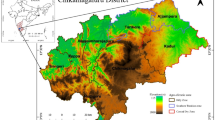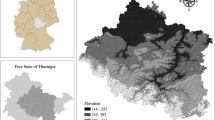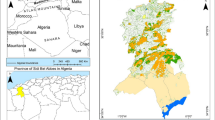Abstract
Increasing demands for agricultural lands and built-up areas, driven by rapid population growth in developing countries including Indonesia, exacerbates the strain on tropical forests. Therefore, crucial to regular maintenance of forest monitoring is necessary to support sustainable forest management and minimize deforestation. In addition, driving factors of deforestation need to be comprehended and serve as considerations in the development of policies and decision-making. The main objective was to provide an in-depth understanding of the phenomenon of deforestation and its underlying variables in tropical regions, with a case study of Katingan Regency, Indonesia. Machine learning for remote sensing data analysis was integrated to investigate multi-temporal land cover in scouting deforestation and its driving factors. We found that the performance of random forests (RF) in all experimental settings was generally superior to support vector machines (SVM), achieving the best overall accuracy of 0.95. Land cover change analysis in the Katingan Regency (covering 2.04 M ha) suggested total deforestation during 2004−2022 of approximately 247.108 ha, an average of almost 14 thousand ha per year. Logistic regression showed that selected predictors significantly influenced the occurrence of deforestation. Non-forest areas devised a greater likelihood of deforestation than designated forest areas. Protected areas acted as an agent to minimize and impede regional deforestation. Meanwhile the probability of deforestation was greater on the outside of forest concession areas. We conclude that efforts to prevent deforestation need to be elevated, particularly in open-access production forests, characterized by high accessibility. In addition, the protection of the remaining forests, especially in non-forest designated areas, needs to be accommodated in regional spatial planning policies.










Similar content being viewed by others
References
Abdi AM (2020) Land cover and land use classification performance of machine learning algorithms in a boreal landscape using Sentinel-2 data. Gisc Remote Sens 57(1):1–20. https://doi.org/10.1080/15481603.2019.1650447
Abdullah AY, Masrur A, Adnan MS, Baky MA, Hassan QK, Dewan A (2019) Spatio-temporal patterns of land use/land cover change in the heterogeneous coastal region of Bangladesh between 1990 and 2017. Remote Sens. https://doi.org/10.3390/rs11070790
Acheampong EO, Macgregor CJ, Sloan S, Sayer J (2019) Deforestation is driven by agricultural expansion in Ghana’s forest reserves. Sci Afr. https://doi.org/10.1016/j.sciaf.2019.e00146
Anderson-Teixeira KJ, Davies SJ, Bennett AC, Gonzalez-Akre EB, Muller-Landau HC, Joseph Wright S, Abu Salim K, Almeyda Zambrano AM, Alonso A, Baltzer JL, Yap S, Zimmerman J (2015) CTFS-ForestGEO: a worldwide network monitoring forests in an era of global change. Glob Chang Biol 21(2):528–549. https://doi.org/10.1111/gcb.12712
Banskota A, Kayastha N, Falkowski MJ, Wulder MA, Froese RE, White JC (2014) Forest monitoring using landsat time series data: a review. Can J Remote Sens 40(5):362–384. https://doi.org/10.1080/07038992.2014.987376
Bonilla-Bedoya S, Estrella-Bastidas A, Molina JR, Herrera MÁ (2018) Socioecological system and potential deforestation in Western Amazon forest landscapes. Sci Tot Environ 644:1044–1055. https://doi.org/10.1016/j.scitotenv.2018.07.028
Braimoh AK, Onishi T (2007) Spatial determinants of urban land use change in Lagos. Nigeria Land Use Pol 24(2):502–515. https://doi.org/10.1016/j.landusepol.2006.09.001
Breiman L (2001) Random forests. Mach Learn 45(1):5–32
Carlson KM, Curran LM, Ratnasari D, Pittman AM, Soares-Filho BS, Asner GP, Trigg SN, Gaveau DA, Lawrence D, Rodrigues HO (2012) Committed carbon emissions, deforestation, and community land conversion from oil palm plantation expansion in West Kalimantan. Indonesia Proc Natl Acad Sci 109(19):7559–7564. https://doi.org/10.1073/pnas.1200452109
Cortes C, Vapnik V (1995) Support-vector networks. Mach Learn 20(3):273–297. https://doi.org/10.1007/BF00994018
Du S, Wang Q, Guo L (2014) Spatially varying relationships between land-cover change and driving factors at multiple sampling scales. J Environ Manage 137:101–110. https://doi.org/10.1016/j.jenvman.2014.01.037
FAO (2020) Global forest assessment resources 2020 Main report. Food and agriculture organization of the United Nations. Rome, Italy
Foley WJ, McIlwee A, Lawler I, Aragones L, Woolnough AP, Berding N (1998) Ecological applications of near infrared reflectance spectroscopy—A tool for rapid, cost-effective prediction of the composition of plant and animal tissues and aspects of animal performance. Oecologia 116(3):293–305. https://doi.org/10.1007/S004420050591
Gaveau DLA (2017) What a difference 4 decades make: Deforestation in Borneo since 1973. CIFOR, Bogor, Indonesia
Ghimire B, Rogan J, Galiano VR, Panday P, Neeti N (2012) An evaluation of bagging, boosting, and random forests for land-cover classification in cape cod, Massachusetts, USA. Gisc Remote Sens 49(5):623–643. https://doi.org/10.2747/1548-1603.49.5.623
Gibson L, Lee TM, Koh LP, Brook BW, Gardner TA, Barlow J, Peres CA, Bradshaw CJA, Laurance WF, Lovejoy TE, Lovejoy TE, Sodhi NS (2011) Primary forests are irreplaceable for sustaining tropical biodiversity. Nature 478(7369):378–381. https://doi.org/10.1038/nature10425
Hansen MC, Potapov PV, Moore R, Hancher M, Turubanova SA, Tyukavina A, Thau D, Stehman SV, Goetz SJ, Loveland TR (2013) High-resolution global maps of 21st-century forest cover change. Science 342(6160):850–853
Hosonuma N, Herold M, De Sy V, De Fries RS, Brockhaus M, Verchot L, Angelsen A, Romijn E (2012) An assessment of deforestation and forest degradation drivers in developing countries. Environ Res Lett. https://doi.org/10.1088/1748-9326/7/4/044009
Juniyanti L, Purnomo H, Kartodihardjo H, Prasetyo LB (2021) Understanding the driving forces and actors of land change due to forestry and agricultural practices in sumatra and kalimantan: a systematic review. Land. https://doi.org/10.3390/land10050463
Keenan RJ, Reams GA, Achard F, de Freitas JV, Grainger A, Lindquist E (2015) Dynamics of global forest area: results from the FAO global forest resources assessment 2015. For Ecol Manage 352:9–20. https://doi.org/10.1016/j.foreco.2015.06.014
Malhi Y, Gardner TA, Goldsmith GR, Silman MR, Zelazowski P (2014) Tropical forests in the anthropocene. Annu Rev Environ Resour 39:125–159. https://doi.org/10.1146/ANNUREV-ENVIRON-030713-155141
Maxwell AE, Warner TA, Fang F (2018) Implementation of machine-learning classification in remote sensing: an applied review. Int J Remote Sens 39(9):2784–2817. https://doi.org/10.1080/01431161.2018.1433343
McCullagh P, Nelder JA (1989) Generalized linear models. CRC Press, Boca Raton
Opelele OM, Yu Y, Fan W, Lubalega T, Chen C, Kachaka SK (2022) Understanding spatial drivers of deforestation in the luki biosphere reserve, democratic Republic of Congo. Appl Ecol Environ Res 20(1):653–670. https://doi.org/10.15666/aeer/2001_653670
Osaki M, Tsuji N (2015) tropical peatland ecosystems. Springer, Japan
Pal M (2005) Random forest classifier for remote sensing classification. Int J Remote Sens 26(1):217–222. https://doi.org/10.1080/01431160412331269698
Panuju DR, Paull DJ, Griffin AL (2020) Change detection techniques based on multispectral images for investigating land cover dynamics. Remote Sens 12(11):1–36. https://doi.org/10.3390/rs12111781
Panuju DR, Paull DJ, Griffin AL, Trisasongko BH (2021) Mapping rice growth stages employing MODIS NDVI and ALOS AVNIR-2. In: Kumar P, Sajjad H, Chaudhary BS, Rawat JS, Rani M (eds) Remote sensing and giscience challenges and future directions. Springer, Cham, pp 185–203. https://doi.org/10.1007/978-3-030-55092-9_11
Panuju DR, Trisasongko BH, Susetyo B, Raimadoya MA, Lees BG (2010) Historical fire detection of tropical forest from NDVI time-series data: Case study on Jambi Indonesia. ITB J Sci 42(1):49–66. https://doi.org/10.5614/itbj.sci.2010.42.1.5
Pause M, Schweitzer C, Rosenthal M, Keuck V, Bumberger J, Dietrich P, Heurich M, Jung A, Lausch A (2016) In situ/remote sensing integration to assess forest health-a review. Remote Sens. https://doi.org/10.3390/rs8060471
Plata-Rocha W, Monjardin-Armenta SA, Pacheco-Angulo CE, Rangel-Peraza JG, Franco-Ochoa C, Mora-Felix ZD (2021) Proximate and underlying deforestation causes in a tropical basin through specialized consultation and spatial logistic regression modeling. Land 10(2):1–18. https://doi.org/10.3390/land10020186
Pontius RG Jr, Millones M (2011) Death to Kappa: birth of quantity disagreement and allocation disagreement for accuracy assessment. Int J Remote Sens 32(15):4407–4429
Ramdhani W, Trisasongko BH (2023) Food crop land allocation: integrating land suitability analysis and spatial forestry, study case Katingan. Indonesia J Manajemen Hutan Tropika 29(3):187–199. https://doi.org/10.7226/jtfm.29.3.187
Rodriguez-Galiano VF, Ghimire B, Rogan J, Chica-Olmo M, Rigol-Sanchez JP (2012) An assessment of the effectiveness of a random forest classifier for land-cover classification. ISPRS J Photogramm Remote Sens 67(1):93–104. https://doi.org/10.1016/j.isprsjprs.2011.11.002
Shi D, Yang X (2016) An assessment of algorithmic parameters affecting image classification accuracy by random forests. Photogramm Eng Remote Sci 82(6):407–417. https://doi.org/10.14358/PERS.82.6.407
Simonetti D, Pimple U, Langner A, Marelli A (2021) Pan-tropical Sentinel-2 cloud-free annual composite datasets. Data Brief 39:107488. https://doi.org/10.1016/j.dib.2021.107488
Sinha S, Jeganathan C, Sharma LK, Nathawat MS (2015) A review of radar remote sensing for biomass estimation. Int J Environ Sci Tech 12(5):1779–1792. https://doi.org/10.1007/s13762-015-0750-0
Souza CM, Shimbo ZJ, Rosa MR, Parente LL, Alencar A, Rudorff BFT, Hasenack H, Matsumoto M, Ferreira GL, Souza-Filho PWM, de Oliveira SW, Rocha WF, Fonseca AV, Marques CB, Diniz CG, Costa D, Monteiro D, Rosa ER, Vélez-Martin E, Weber EJ, Lenti FEB, Paternost FF, Pareyn FGC, Siqueira JV, Viera JL, Neto LCF, Saraiva MM, Sales MH, Salgado MPG, Vasconcelos R, Galano S, Mesquita VV, Azevedo T (2020) Reconstructing three decades of land use and land cover changes in brazilian biomes with landsat archive and earth engine. Remote Sens 12(17):52. https://doi.org/10.3390/rs12172735
Talukdar S, Singha P, Mahato S, Shahfahad Pal S, Liou YA, Rahman A (2020) Land-use land-cover classification by machine learning classifiers for satellite observations-A review. Remote Sens 12(7):85. https://doi.org/10.3390/rs12071135
Trisasongko BH, Panuju DR, Karyati NE, Sholihah RI, Griffin AL (2023) Rural land cover mapping using short-term Sentinel-2 temporal composites and machine learning. J Appl Remote Sens 17(2):024517. https://doi.org/10.1117/1.JRS.17.024517
Trisasongko BH, Panuju DR, Paull DJ, Jia X, Griffin AL (2017) Comparing six pixel-wise classifiers for tropical rural land cover mapping using four forms of fully polarimetric SAR data. Int J Remote Sens 38(11):3274–3293. https://doi.org/10.1080/01431161.2017.1292072
Trisasongko BH, Paull DJ (2020) L-band SAR for estimating aboveground biomass of rubber plantation in Java Island. Indonesia Geocarto Int 35(12):1327–1342. https://doi.org/10.1080/10106049.2019.1573855
Trisasongko BH, Paull DJ, Griffin AL, Jia X, Panuju DR (2019) On the relationship between the circumference of rubber trees and L-band waves. Int J Remote Sens 40(16):6395–6417. https://doi.org/10.1080/01431161.2019.1591650
Ul Din S, Mak HW (2021) Retrieval of land-use/land cover change (LUCC) maps and urban expansion dynamics of Hyderabad, Pakistan via landsat datasets and support vector machine framework. Remote Sens 13(16):52. https://doi.org/10.3390/rs13163337
Vapnik VN (2000) The nature of statistical learning theory, 2nd edn. Springer Verlag, New York
Vu QM, Le QB, Frossard E, Vlek PLG (2014) Socio-economic and biophysical determinants of land degradation in Vietnam: an integrated causal analysis at the national level. Land Use Pol 36:605–617. https://doi.org/10.1016/J.LANDUSEPOL.2013.10.012
Yang X (2011) Parameterizing support vector machines for land cover classification. Photogramm Eng Remote Sens 77(1):27–37. https://doi.org/10.14358/PERS.77.1.27
Acknowledgements
The authors would like to thank to the Ministry of National Development Planning/ National Development Planning Agency (Bappenas) for providing scholarship, funds and opportunities for this research.
Author information
Authors and Affiliations
Corresponding author
Ethics declarations
Conflict of interest
The authors declare no confict of interest.
Additional information
Publisher's Note
Springer Nature remains neutral with regard to jurisdictional claims in published maps and institutional affiliations.
About this article
Cite this article
Ramdhani, Trisasongko, B.H. & Widiatmaka Understanding deforestation in the tropics: post-classification detection using machine learning and probing its driving forces in Katingan, Indonesia. Asia-Pac J Reg Sci (2024). https://doi.org/10.1007/s41685-024-00330-0
Received:
Accepted:
Published:
DOI: https://doi.org/10.1007/s41685-024-00330-0




